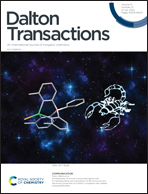Fluorinated click-derived tripodal ligands drive spin crossover in both iron(ii) and cobalt(ii) complexes†
Abstract
Control of the spin state of metal complexes is important because it leads to a precise control over the physical properties and the chemical reactivity of the metal complexes. Currently, controlling the spin state in metal complexes is challenging because a precise control of the properties of the secondary coordination sphere is often difficult. It has been shown that non-covalent interactions in the secondary coordination sphere of transition metal complexes can enable spin state control. Here we exploit this strategy for fluorinated triazole ligands and present mononuclear CoII and FeII complexes with “click”-derived tripodal ligands that contain mono-fluorinated benzyl substituents on the backbone. Structural characterization of 1 and 2 at 100 K revealed Co–N bond lengths that are typical of high spin (HS) CoII complexes. In contrast, the Fe–N bond lengths for 3 are characteristic of a low spin (LS) FeII state. All complexes show an intramolecular face-to-face non-covalent interaction between two arms of the ligand. The influence of the substituents and of their geometric structure on the spin state of the metal center was investigated through SQUID magnetometry, which revealed spin crossover occurring in compounds 1 and 3. EPR spectroscopy sheds further light on the electronic structures of 1 and 2 in their low- and high-spin states. Quantum-chemical calculations of the fluorobenzene molecule were performed to obtain insight into the influence of fluorine-specific interactions. Interestingly, this work shows that the same fluorinated tripodal ligands induce SCO behavior in both FeII and CoII complexes.

- This article is part of the themed collection: Spotlight Collection: Fluorinated ligands


 Please wait while we load your content...
Please wait while we load your content...